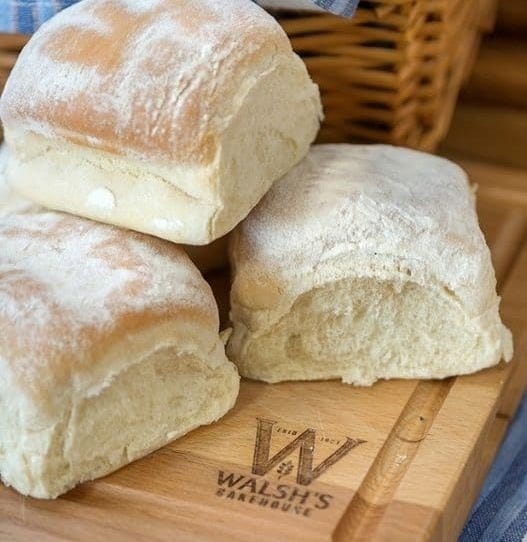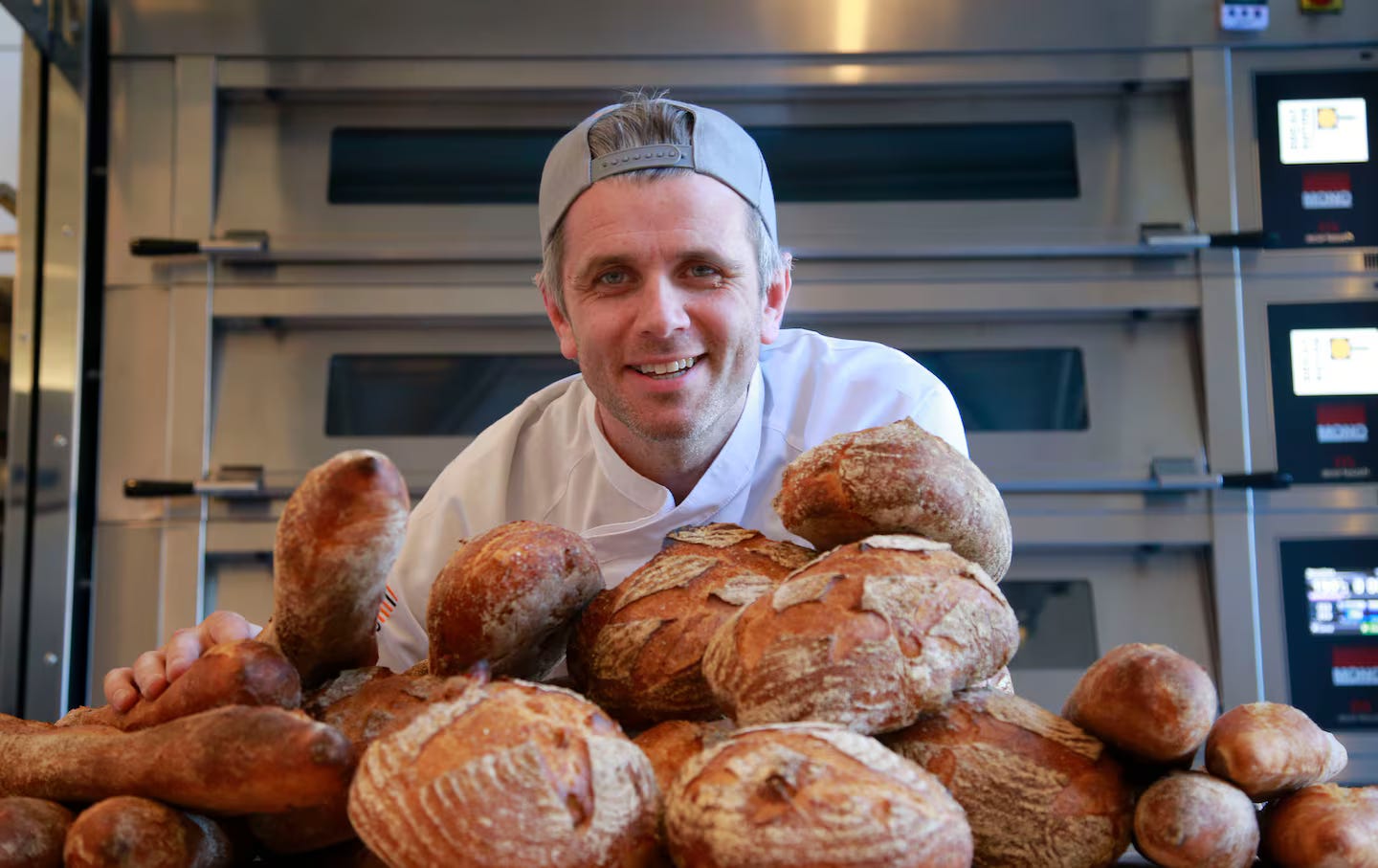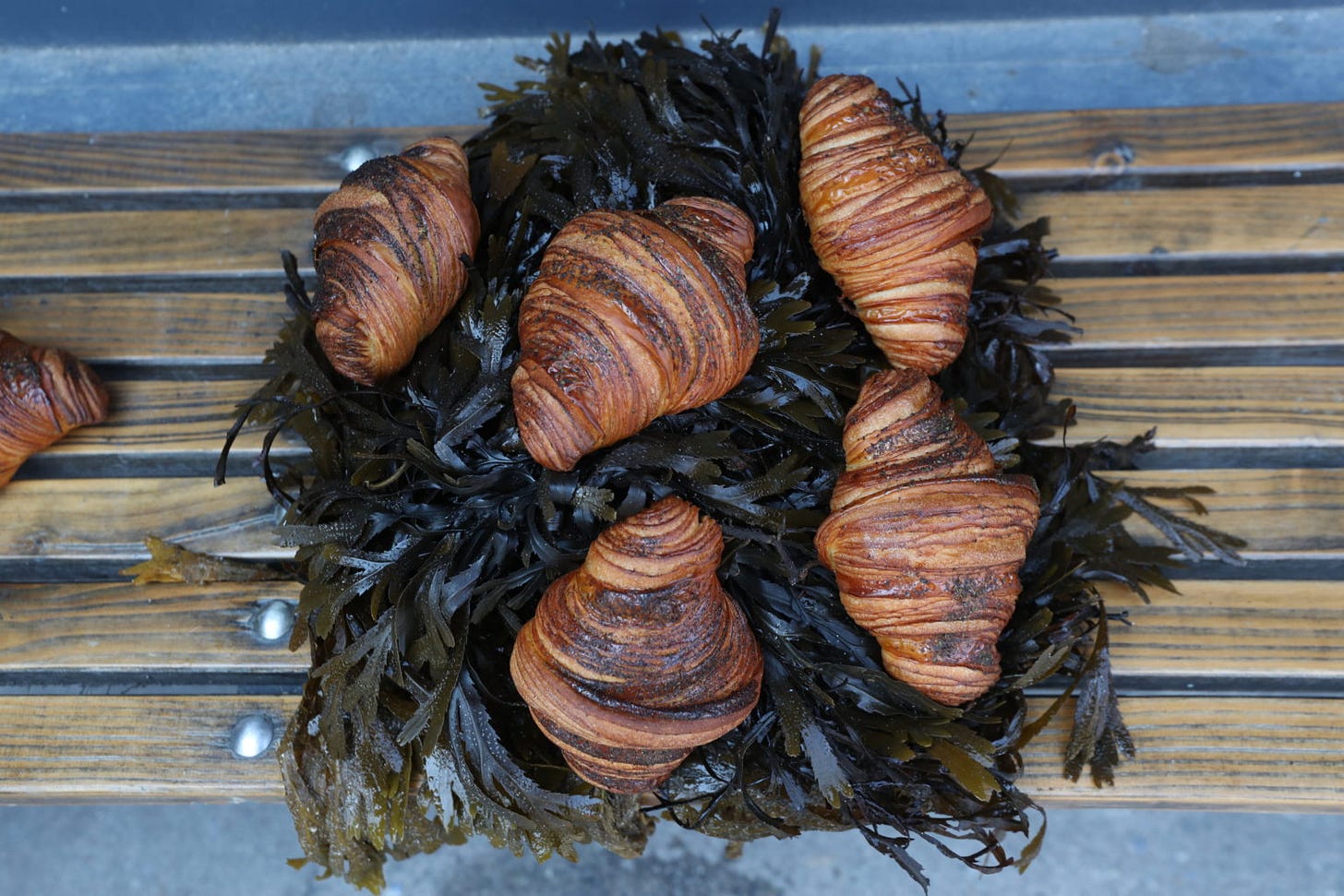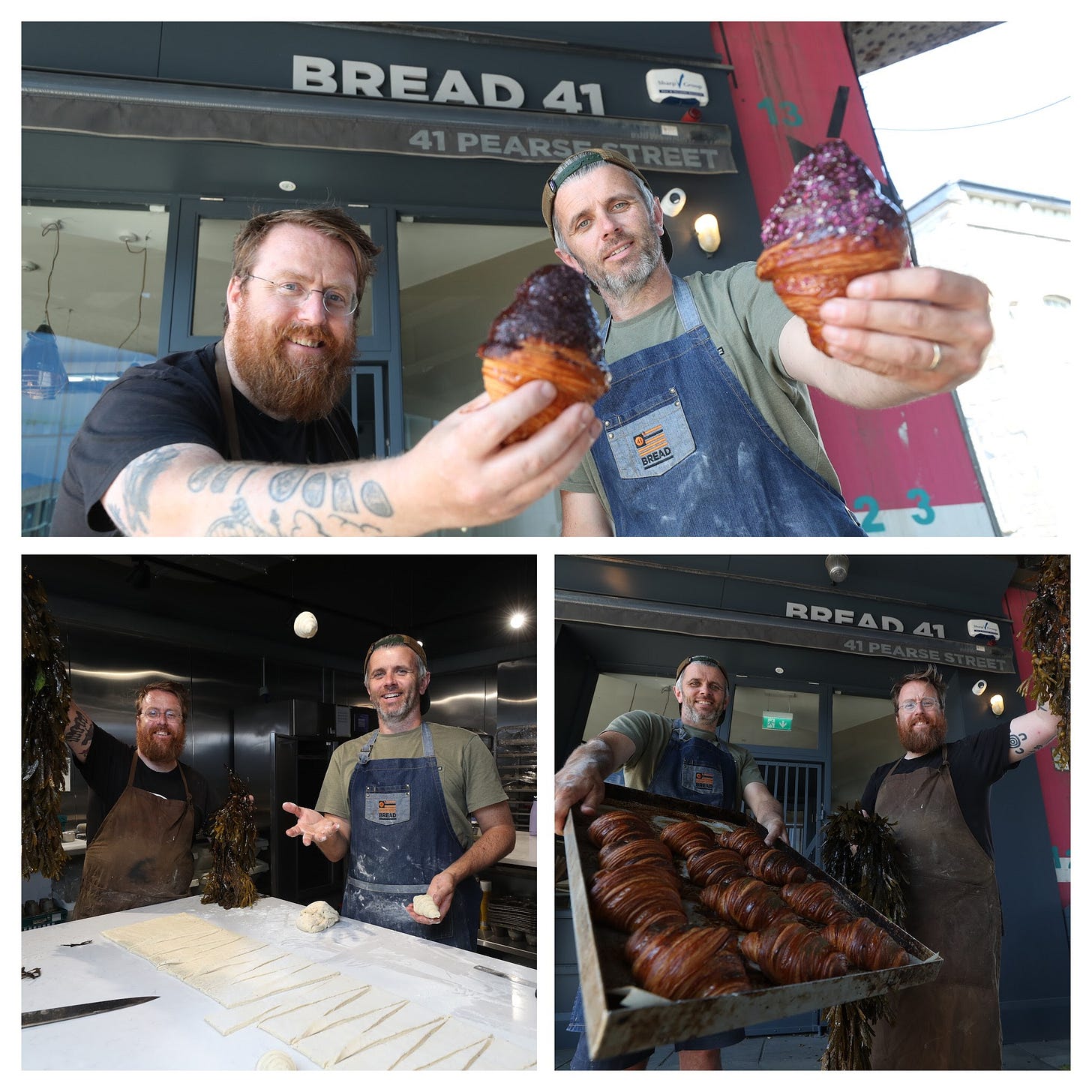A History of Irish Baking (Part 12)
From Boxty to Bagels; from soda bread to sourdough and seaweed croissants.
…and suddenly we have reached the end of our 10,000 year journey into Irish baking and baking in Ireland. Just over three months ago, I begin this this series with a question. How do we define Irish baking:
Like the idea of Irish food, Irish baking is a difficult proposition. How do we define it? What are its limits? A complete understanding of Irish baking needs to not only take in any indigenous Irish baking tradition, which arises on the island of Ireland, but also the other baking traditions that became incorporated into story of baking on this island through migration and travel.
Most than any other period, the last thirty-five years have demonstrated the dual position of baking in Ireland. It’s not simply a question of soda bread vs. the world. It’s an ongoing marriage with its ups and downs, it’s something that continually evolves. Food culture is never static. Baker Graham Herterich exemplifies this trend in his book Bake (Nine Bean Rows, 2022), wherein he gave traditional bakes (soda bread, porter cake, brack, etc.) a contemporary spin alongside ‘modern classics like jambons, cheesecakes and fifteens’, using globally inspired ingredients ‘from advieh (a Persian spice blend, meaning ‘spice mixture’ in Farsi,) to zhug (a spicy, green hot sauce originating from Yemen and widely popular throughout the Middle East)’ now available in Ireland. Such fusions kept age-old treats relevant for younger palates as well as updating Irish food culture for the 21st century. Tradition and innovation are not opposites as our dillisk croissants demonstrated in the post-pandemic landscape of Irish baking.
Baking culture in Ireland from 1991 to 2025 evolved from traditional home baking to sophisticated artisanal trends, reflecting broader shifts in our food culture, massive economic change, and global influence due a digital revolution. It was a seemingly circular path that took us from home baked soda bread to sourdough and back to soda bread again, to the confinement of our homes during Covid where both types of bread were baked with great acuity.
It is a tale that takes us home-baking of our mothers and grandmothers in the early 90’s to the 'stay at home' baking that so many of us devoted ourselves to during the Covid years (2020-2022). Though many may argue that sourdough won the covid bread battle, in truth it matters not, because the whole country got baking again. Ireland baked more during Covid that any other period in the last fifty years.
Irish food culture from 1991 to 2025 underwent a remarkable transformation, one that took place during my own lifetime, from traditional simplicity to modern innovation, shaped by globalization, economic shifts, and a newfound pride in local ingredients. In the early 1990s, Ireland’s food culture remained largely traditional. Typical meals featured simple, hearty dishes like, Irish stew (we ate it once a week). In terms of home baking, soda bread (which my grandma made every few days) was the most popular home baked bread.
In the 1990s, baking was deeply embedded in Irish homes, passed down generationally. Baking was a common domestic skill, primarily associated with homemaking traditions, celebrations, and religious occasions. My mother regularly baked scones and sponge cakes for birthdays. Homemade apple tarts and pies abounded.
There was a limited bakery culture between 1991 and 2000. Commercial bakeries were traditional, with small bakeries and grocery stores dominating, focusing on Irish staples mixed with some European influence. My favourite growing up was the Elite Bakery in Maynooth, which produced a variety of breads, buns, and pastries. Croissants, for example, only became widespread towards the mid 1990s due to increasing international travel by the Irish public, notably to France and continental Europe. Expansion of supermarket bakeries and cafés, including European-style café chains, introducing croissants as everyday items.
During this period, eating out was typically reserved for special occasions, often in simple pubs or hotel restaurants. International influences were limited, but early signs of culinary globalization emerged toward the late 1990s. I took my first chef job in Maynooth University in 1994 and then worked in an Italian Restaurant called Donatello’s in 1995 in Maynooth where I was first introduced to Italian yeasted bread made with extra virgin olive oil. To say I fell in love with this bread would be an understatement.
The economic boom (‘Celtic Tiger’) from 1995 to around 2007 dramatically impacted Irish food culture. Increased wealth and tourism introduced international cuisines, expanding tastes and expectations. There was an emergence of fusion restaurants blending Irish ingredients with Asian, Mediterranean, and American influences. Influenced by continental Europe, cafés serving espresso coffees paired with croissants, Danish pastries, muffins, brownies, and cheesecakes became commonplace in both the larger cities as well as the small ones.
Economic prosperity contributed to the rise in café culture, and the consumption of a multitude of baked goods, from French patisseries (croissants), Italian-style breads (ciabatta, focaccia), and American-style cupcakes, bagels, muffins, and cookies. Yet, despite globalization, nostalgia for traditional Irish dishes remained strong, often reinterpreted creatively.
The bagel arrived in Ireland around 1995, introduced primarily through supermarkets and specialty cafés, influenced by growing international travel and exposure to American culture, particularly from Dublin outward.1 Chains like Bagel Factory (founded in Dublin in 1997) and various independent bagel shops began serving fresh bagels, initially targeting city professionals, students, and tourists. Domini Kemp, alongside her sister Peaches Kemp, opened their first bagel café, Itsa Bagel, in December 1999 at the Epicurean Food Hall on Middle Abbey Street in Dublin. This venture introduced New York–style bagels to Ireland, marking a significant moment in the country's culinary landscape at the turn of the millennium.
Arbutus Bread is a renowned artisan bakery based in Cork, Ireland, founded in 1999 by Declan Ryan, Ireland's first Michelin-starred chef. After selling his previous business, Arbutus Lodge Hotel, Ryan converted a small garage in front of his house into a bakery, where he began producing bread using traditional artisan methods.
Drawing inspiration from his experiences in France and training with esteemed bakers Pierre Nury and Xavier Honorin, Ryan developed a range of sourdough and yeast breads. The bakery quickly outgrew its original location, leading to the establishment of a larger facility in Mayfield, Cork. Their commitment to natural ingredients and traditional methods has made them a staple in the Irish artisan bread scene.2
Supermarket baking, which began with Quinnsworth in the 1970s, became more sophisticated offering convenience with international-style breads, baguettes, bagels, and pastries. We were all enamoured with Cuisine de France bread and croissants when they arrived in the shops (from 1989 onwards). Like other bread, they were ‘baked in store daily’. They forgot to add that they were baked in store daily from frozen, but we didn’t care. We loved these French baguettes. They made us feel a little more European. Due to the availability of cheaper bread home baking declined due to busier lifestyles and greater availability of shop-bought alternatives. I witnessed this between the generation of my grandparents and my parents whereby greater economic wealth and larger families, and busier lives reduced people’s ability to bake at home.
At key moment for the new millennium was the purchase of The Bretzel Bakery by William Despard who brought a scientific approach to traditional baking methods. Under his leadership, Bretzel expanded its operations, moving primary production to a modern facility in Harold’s Cross in 2013, while retaining the original Lennox Street location as a shop and café. Though established in 1870 in Dublin's Portobello neighborhood to serve the local Jewish community in what was known as ‘Little Jerusalem’, Despard has demonstrated a commitment to artisanal bread-making, emphasizing long fermentation processes and high-quality ingredients.
The economic downturn of 2008-2013 influenced food habits significantly. Consumers returned to home cooking, but with greater awareness about quality, provenance, and affordability. During this period there was a surge of artisan producers (cheesemakers, bakers, brewers, whiskey distilleries) as well as a growing interest in the ‘Farm-to-table’ and ‘Slow Food’ movements gained popularity.
Ultimately, the 2008 recession and post-recession period encouraged a revival in artisanal and homemade baking. Small, high-quality bakeries emerged, emphasizing handcrafted sourdough breads, rye breads, spelt breads, and specialty pastries. Renewed interest in home baking driven by economic necessity, nostalgia, and popular media (e.g., TV baking shows like ‘The Great British Bake Off’ and its Irish adaptations fueled a mini home baking revolution. All the while, there was a greater emphasis on quality, local flour, organic produce, and Irish dairy ingredients, boosting small-scale farmers and mills.
The Waterford Blaa, a soft, floury white bread roll tracing back to the arrival of French Huguenots in the 1690s, gained Protected Geographical Indication status (PGI) in 2013, joining the ranks of Champagne and Parma ham. This EU recognition not only safeguarded its authenticity but signaled a revival of pride in regional specialties. In fact, an association of the only four bakeries who make genuine Waterford blaa formed to protect its legacy, ensuring that such traditional recipes survived into the 21st century.
The period between 2015-2020 saw a blooming of Irish food, both nationally and internationally. Irish food culture found global acclaim through storytelling, branding, and export of artisanal products (whiskeys, gins, craft beers, seaweed products). Ireland became known internationally for modern twists on heritage ingredients, such as Irish seaweed (kelp, dulse), farmhouse cheeses, sustainably farmed seafood, and pasture-raised meats. Writing for National Bread Week in September 2017, Irish chef Darina Allen observed:
Increasingly, I now seek out organic flour and flour made from heirloom varieties. Still a bit difficult to source but several small Irish millers are trialling old varieties of wheat and Shipton Mill, Doves and Marriages in the UK offer a wide variety of ancient grain flours such as Einkorn, Emmer, Khorason, Spelt, Rye. On a recent trip to Denmark, I met Fintan Keenan, an Irish man working with Danish farmers Per and Gitte Grupe on Mordrupegard who are growing 120 different types of heirloom grains on their farm. He himself is trialling 16, old Irish grains collected from seed banks both here in Ireland and abroad. The Nordic region has a particularly rich tradition and there is indeed a growing interest in these older varieties, now that gluten intolerance seems to have reached an all-time high.
In 2014, Patrick Ryan co-founded The Firehouse Bakery & Bread School (Wicklow & Cork) and co-authored Bread Revolution. A young artisan baker at the time, Ryan was passionate about demystifying bread. He ran hands-on workshops in sourdough and wood-fired baking trying to teach everyone about bread. He famously remarked that, ‘If the next generation don’t bake then that family tradition will be lost’, encapsulating his mission to inspire youth. Ryan’s YouTube bread tutorials (in collaboration with ILoveCooking.ie) garnered millions of views, spreading Irish bread culture globally.
Sustainability, climate-consciousness, and reducing food waste also became core values for many bakeries in Ireland, such as Bread 41, an organic bakery which opened in Dublin in September 2018.
COVID-19's impact (2020–2022) reshaped Ireland’s food scene and its culinary identity significantly. During Covid, there was a surge in home-cooking skills and interest in local sourcing intensified due to reduced mobility of people. Due to the covid payment there was increased support for local food producers and restaurants. Digital delivery platforms and meal kits grew rapidly.
The ‘home baking Boom’ (2020-2022) Baking (particularly for sourdough bread, banana bread, and cakes) surged dramatically as a popular hobby during lockdowns. Instagram and TikTok shaped these baking trends as people posted pictures and videos of their efforts (my daughter Martha and I baked plenty and even learned how to make croissants at home).
The post pandemic space is a precarious one. Perhaps not the most precarious in the history of baking in Ireland, but precarious none the less. The last three years (2022-2025) has witnessed a simultaneous expansion and contraction in terms of baking culture in Ireland. The post-pandemic period sees the growth of specialty and artisanal bakeries, and independent coffee-shop bakeries selling premium sourdough (Bread 41 has expanded to two more locations), pastries, vegan baked goods, and refined patisserie items (
While the sourdough craze has somewhat abated (I can’t remember the last time I made sourdough at home), issues of sustainability are still at the forefront of Irish baking culture. There is a growing popularity of heritage wheat varieties, organic, sustainably sourced flours, local Irish grains, and ancient grains (spelt, rye, einkorn).
The production of fusion pastries blending Irish ingredients with Japanese, Scandinavian, French techniques (e.g., matcha-infused soda bread, miso caramel buns, seaweed biscuits) continue. We make our own oat and dillisk cookies in the restaurant as well as Portugues custard tarts with woodruff instead of cinnamon and seaweed croissants.
In all, Irish baking between the years 1991 and 2025 evolved from traditional home-centric traditions towards a globally influenced artisanal culture. Despite modernization, there remains a keen sense of nostalgia and respect for traditional baking, often reinvented creatively, by bakers and chefs on a daily basis.
The transition from traditional comfort dishes toward an innovative, globalized culinary landscape, strongly defined by local sourcing, sustainability, and artisanal craftsmanship has made Ireland a unique food destination that blends heritage with forward-thinking creativity.
Where our bread will go next is hard to tell, but as with everything we do in Ireland, I don’t think it will be boring.
I hope you have enjoyed this series, and I look forward to my next book The Irish Baking Book which will be published by Nine Bean Rows in 2026.
Jp.
17th April, 2025.
There is a case to made that the Bretzel Bakery founded in 1870 served Dublin’s first bagels along with other Jewish breads such as challah bread, rye bread, Matzo bread, Bialys and Rolls (Savory, chewy rolls popular in Eastern European Jewish communities) and assorted sweet Pastries (such as rugelach, babka, or simple fruit-filled pastries) common in Jewish bakeries in the late 19th century.
In mid-2024, Declan and his wife Patsy announced their retirement and the sale of Arbutus Breads to Dublin-based Bretzel Bakery. The acquisition aimed to ensure continuity, with plans to maintain operations as before.











Thank you so much for this series. I've really enjoyed it. I'm looking forward to your book in 2026!